by Winding Pathways | May 9, 2017 | Flowers/Grasses, Nature, Trees/Shrubs, Wonderment
We invited readers of Winding Pathways blogs to submit a photo and short description of a favorite spring scene. The response spanned from the Pacific Northwest to Canada and from the Desert Southwest to New England. Enjoy readers’ reflections on our emerging spring. The essays appear as they came in to Winding Pathways. Thank you all for your charming observations. Happy Spring! And soon, welcome summer.
***
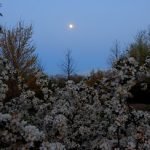
“Every year I wait for our Sargentina crab apple trees to bloom.”
As much as I love our native prairie plants and various garden inhabitants, every year I wait for our Sargentina crab apple trees to bloom. Not too long ago, in the company of one of our barn cats, I sat out on the patio and watched the full moon rise with the sweet smell of the flowers drifting over. Bees lay full claim to the blossoms during the day, from the little sweat bees to the bumbles, so I try to give them some space and wait until evening before diving nose-first into the branches myself.
Emily Groom Hemmerling, Kansas
***
Here in NH, spring is slowly unfolding. The barred owls are getting amorous and I’ve heard, although not seen, “our” hawks. There’s a barn swallow that’s building a nest under the eaves, and the bear visited the other night. The weather seems to be lacking any nuance. We are alternating between two or three days of cold, windy, rainy (tell the truth–nasty) days and occasional beautiful sunny days in the ’70s.
Waiting is hard after a long winter, but change should accelerate very soon. The hummingbirds return on average on May 11th, and by then many flowers should be in bloom and the trees that are barely budding today will be fully green. This time of year Carly Simon is often on my mind–“Anticipation”. Sue Fehsinger, New Hampshire
-
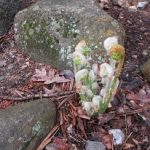
-
Unwinding slowly, fiddle head ferns appear mysteriously.
-
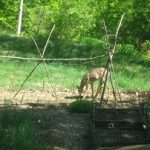
-
Deer In Garden
-
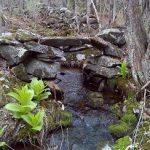
-
A New Hampshire springtime brook graced with Skunk Cabbage.
-
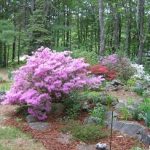
-
A splash of color!
***
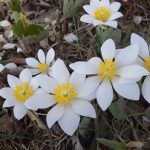
Dazzling white petal surround deep yellow centers.
These Bloodroots are found at the western end of our road. We have now lived on this road for 17 years and have watched the progression of growth and expansion each year of more and more desirable plants. The area has become a huge carpet of white under all the trees. The blossoms on the north side of the road show their faces first and a few days later the blossoms on the south side of the road appear. Since we have been here, each year it has been the same blooming schedule. We also have Bloodroots in our yard which don’t appear until the ones on the road seem to be in full bloom. They are only 1/4 mile apart.
I photographed this forsythia at the edge of our neighbor’s property. I do not have any on our property. It was a beautiful sunny day and the yellow of the blossoms was brilliant. I was also trying to get a different angle on the blossoms, rather than the whole bush.
My purple hyacinths are still producing blooms in my small north facing garden. This year they seemed to have a deeper purple color and more blossoms on the stock.
The Virginia bluebells are now blossoming. I counted 16 clumps of them in a small area at the top of our dry kettle. I am even finding small self-seeded plants.
We are privileged to see wood ducks in our channel in the early spring. They are very skittish and it is difficult to sneak up on them to get a photo. We see them for a short time and then they disappear until next year. Sue Hrobar, Wisconsin
-
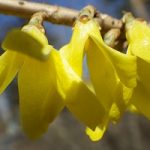
-
Like gold the flowers shine.
-
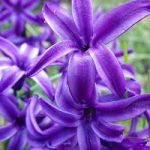
-
Beautiful Purple Blossoms
-
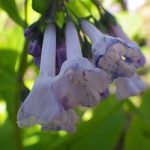
-
Close-up view
-

-
Searching for the right home.
***
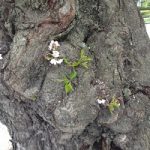
The ancient tree sprouted leaves and flowers all over.
I walked this Chestnut Hill neighborhood in Boston often while living and working in the area. My first fall a few heavily gnarled trunks of a handful of trees planted in the boulevard strips particularly captivated me. These trunks reminded me of Italian grandmothers; stout, sturdy, not particularly tall, deeply wrinkled and absolutely beautiful. When spring arrived I was amazed to see how blossoms not only appeared in their canopies but also sprang from their very bark. I loved these elderly trees all the more and saw them as clothed from head to toe in spring attire. May all of us exhibit such beauty and grace as we mature. Adria J, Illinois and Maine
***
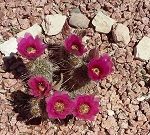
The desert Southwest alive with color.
Here is my first cactus bloom of the season! Soon my yard will be bursting with color, from all of the different cacti!
Coming from the Midwest, this is such a different sort of pretty. Most of the year it is dry and barren up here in the high desert. These little bursts of color that pop up in the spring are such a delight! I love to walk in my neighborhood and see all of the different blooms. We have a very mild winter and sometimes it’s hard to tell that spring is here, at least for this Midwestern gal. The flowers alert me that spring has indeed arrived! Such a contrast to these prickly little fellows. Add to that the brilliant green of the trees, looking almost iridescent, and the scent of the roses that pop up everywhere, I would say that spring is my
favorite season here. Deb Karpek, Arizona
***
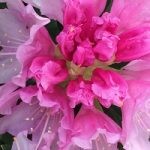
A close up of a western Rhododendron.
After the daffodils and the flowering trees fade is time in the Pacific Northwest for our native rhododendron to flower. They grow wild on the coast, but also are prized in yards because their large leaves are green all winter. Found growing wild near Port Discovery on the Washington coast in 1792 by Archibald Menzies who was with George Vancouver, it has been a favorite ever since. Officially it has been the Washington state flower since 1995, but women in 1893 designated it as such for a Worlds Fair that year. The rhododendron pictured is the Washington Centennial rhododendron from 1989. I love the way the blooms start out bright pink and fade to a pale pink as they open.
Jocelyn Berriochoa, Washington state
***

Raindrops on lilacs.
I opened the door this morning and looked out to see our lilacs blooming; pretty as could be. I thought, “Thank you, Grandma, for planting them over seventy plus years ago.” What a special way to start the day and welcome some of the beauty of spring. Claire Patterson, New Jersey
***
Spring came early to Bedford, Virginia, this year by about three weeks which means farmers, orchardists and gardeners began planting and hoping for early crops. Then to their surprise, we had two serious freezes back-to-back in March. The orchardists were especially chagrined because peaches, pears and apples took a hit. Watch for rising fruit prices.
As a gardener, it was thrilling to clean out the flowers and raised vegetable beds early on. As I began checking the asparagus patch, I noticed two silvery milkweed spears poking their heads through the soil next to the asparagus. They had begun their quiet vigil for the returning Monarch butterflies. I know the Monarchs have reached their most northern breeding grounds. However, I’ve not seen one returning Monarch here at the Ridge House.
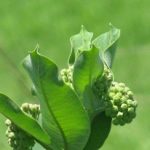
Milkweed is an important plant for Monarchs and other pollinators.
How did the milkweed come to be in my asparagus bed? There are a number of possibilities. Perhaps the birds deposited the seeds long ago. Or, the wind may have blown these wispy silky pinwheels into the patch. Another thought occurred to me that the seeds may have been tangled in the straw I scattered in the patch to help hold moisture through the dry summer months. However the seeds arrived, they are a God send as unthinking highway department mowers clear the roadsides, or a farmer applies toxic weed killer, or a home owner wanting a pristine lawn shears them off. The end result is far fewer pollinators like Monarchs and other butterflies, bees, and even birds. Where am I going with this you ask? This sage says, “All my weeds are wildflowers.” Peace. Jackie Hull, Virginia
***
-

-
Spring in NYC
-

-
New York City is awash with soft color in the spring.
Spring in New York City. Dan Patterson, New York
***
Snow is melting gradually this spring. And, despite the string of rainy days lately, at the end of April we still had mounds of it around the house and in the woods.
The slow melt has meant that I’ve kept up with yard cleanup and, while trimming around the edge of the yard, I have come across early gems, like the bright purple crocuses with their eye-popping yellow-orange stamen, nestled among moss covered rocks near the path into the woods.
Elsewhere, along the edge of the woods, the early Spring ground cover, known as ‘William & Mary’, is starting to show its pink and blue blossoms. (I think of my patch as ‘Will & Kate’.)
And, I uncovered the little pile of beach stones that granddaughter Cadence assembled one summer.
Every Spring is different and every day brings different discoveries and possibilities in the garden.
Now, I’m headed out and about to see what new stuff is uncovered before the heavy rains come. I’m thankful we live outside the flood zone, but Fredericton will see another 100 year flood this weekend I fear. Lucy Fellows, New Brunswick, Canada
-
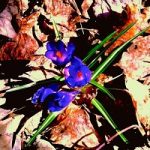
-
Poking through the leaves is a burst of color.
-

-
A stack of pebbles.
-

-
Early spring arrival
by Winding Pathways | Apr 22, 2017 | Birds, Flowers/Grasses, Nature, Trees/Shrubs, Wonderment
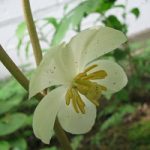
Beautiful blossoms hide under the umbrella-like leaves.
First submission in! Hey all, on Facebook Winding Pathways invited folks to submit a favorite spring photo – tree, scene, flower, animal – with a short write-up of why you like that picture. And, Kansas readers Emily and Zach Hemmerling have already replied! Way to Go!
Now, I’d love to have about a dozen more so send them in to our email and I’ll continue processing and then post. These samples of spring pictures. Join in the fun and share your descriptions!
-

-
Photo – Protective custody
-

-
Photo of sheep in pasture
-

-
Kids develop strength, cooperation, and curiosity as they explore outside.
-
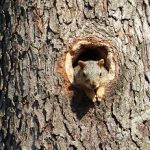
-
It’s a long way down, Mom.
-
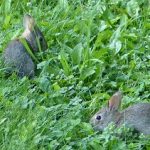
-
Bunnies are on their own as soon as the mother weens them.
-

-
Photo – On a wild and windy day this Cardinal sang out his love song.
-
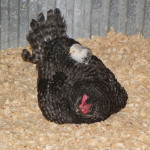
-
This mama hen with chick on her back fluffs up clean wood chips.
-
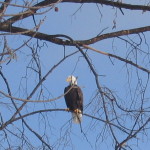
-
Eagle watching over nest.
-
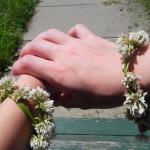
-
Clover bracelets
by Winding Pathways | Aug 26, 2016 | (Sub)Urban Homesteading, Garden/Yard, Nature, Trees/Shrubs
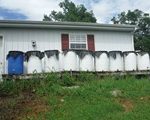
A Guest Column by Jackie and Peter Hull
When we first moved to Virginia fifteen years ago, we had no idea that the entire state was in a drought which had been ongoing for a couple of years. In order to help water the garden we wanted to grow, we decided to construct rain barrels. We had seen the master gardeners of Bedford, VA, demonstrate how to put them together.
To begin we bought four 55-gallon barrels from Southern Flavorings for $10 apiece. The faucets and pool filters added another $15 bringing the total to $25 a barrel as opposed to $75 to $100 a piece fully equipped from a company. When we modified our barrels a few years later no longer using pool filters, we had to add the cost of screening and bungee cords which made a total of $30 a barrel.
In outfitting the barrels Peter cut circular holes in the top of each barrel and fitted them with pool filters to catch debris and give an access to help clean out the barrels in the fall. About five inches from the bottom of the barrels he cut holes just large enough to insert the faucets and rings. To help seal this entrance he used caulking compound. He modified the down spout of the rain gutter to arc over the pool filter to catch the rain. The remaining barrels sat adjacent to the first barrel and each was attached to the other with a short piece of PVC pipe that was inserted from one barrel to the next so the water would flow filling each barrel. The last barrel had an overflow spout at the top pointing to the ground so once it was filled the rain water could dribble to the ground.
As we added more barrels, Peter changed from cutting holes in the top of the barrels to cutting the entire top off and covering with plastic screen and using a bungee cord. Fortunately, the top of each barrel has a lip so the bungee cord fits snugly around the barrel holding the screen securely in place. His thinking was this would make cleaning the barrels much easier. It is. To keep mosquito larvae to a minimum, we put a mosquito donut into each barrel. The screening also protects the birds which was initially my concern when he decided to cut the tops entirely off.
All the barrels sit on benches that we constructed so that the water is gravity fed to the garden through a number of hoses. Over the past several years we’ve added more barrels for a total of eleven rain barrels containing 55 gallons each for a total of 550 gallons of water collected from the metal roofed house and garage. This year we’ve emptied them twice over the growing season as we’ve had alternating rain and warm sunshine.
Winding Pathways Notes: Some people may prefer to buy rain barrels ready to install. Most large home improvement stores sell barrels as do many nature centers. Also, be aware that in some arid areas harvesting rain water is in dispute or illegal unless a person owns the water rights. These laws are changing as times and uses change.
by Winding Pathways | May 25, 2016 | Nature, Trees/Shrubs
Years ago a tremendous lightning bolt struck a white pine at the Indian Creek Nature Center in Cedar Rapids, Iowa.
The powerful blast tore a vertical strip of bark from nearly the tree’s top to the ground. It was at least 25 feet long and about four inches wide. Fearing that the hit was fatal I called then Cedar Rapids City Forester Eric Faaborg who came out and examined the pine.
I was certain it had suffered the kiss of death, but Eric reassured me. “I don’t think the hit was fatal. Give it a few years and see what happens,” he remarked.
He was correct. By the next year the pine had partially healed. Now about 20 years later it is healthy and has grown considerably. The scar from the lightning wound is still visible but has faded.
The massive white oak that was struck by lightning near our home at Winding Pathways isn’t as lucky. Unlike the pine, the oak suffered extreme damage that extended all around the circumference of the tree. Four vertical strips of bark were torn off, and where bark remained it had been blown away from the tree’s wood. Essentially the oak has been girdled. We expect it to slowly die.
According to Cedar Rapids arborist, Todd Fagan, lightning damage often stresses a tree, causing it to go into decline and eventually die. It also opens the tree up to insects and diseases. However lightning damage isn’t always fatal. If in doubt he suggests contacting a certified arborist to evaluate the tree. Or you can simply leave it in place and remove if it dies.
Fagan added that it is possible to prevent lightning damage to special trees. “Often trees on golf courses are fitted with a copper wire that channels lightning harmlessly down into the ground. It’s expensive but can prevent the loss of an especially valuable tree,” he remarked.
To locate a certified arborist in your area access the website of the International Society of Aboriculture at and click on the appropriate link.
by Winding Pathways | May 16, 2016 | Geology/Weather, Nature, Trees/Shrubs
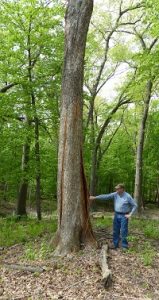
This stately Oak took a full bodies hit that vaporized the sap and blew off the bark in four places.
An enormous explosion brought us bolt upright in bed. 10:44 p.m. just after we’d fallen asleep on April 27th. . The blast was so powerful it knocked pictures off the wall shattering the frames and glass. A quick check revealed no other home damage and a few low rumbles assured us that the noise had been thunder created by a very close lighting strike and not a bomb.
A few days later we discovered a massive white oak about 300 feet from our home with its bark blown off in four different places and loose in others. The lightning’s heat and force vaporized the tree’s sap and enormous pressure blew the bark off. It’s hard to imagine that so much damage could happen in a two tenths of a second-long lightning bolt. The thing is, the tree top is lower than our home! Why did lightning strike there and not the house?
A lightning strike isn’t always a tree’s kiss of death. If only a narrow swath of bark is blown off it may recover. But we fear our magnificent oak was so damaged that its days are numbered.
The tree’s imminent death is good news for small songbirds, especially brown creepers that seek shelter between loose bark and a tree’s trunk. As the oak gradually deteriorates it will provide food and shelter for a host of insects and the woodpeckers that love dining on them. We anticipate a day when our pileated, red headed, red bellied, hairy and downy woodpeckers nest in the old oak snag. Eventually it will topple over and over time return nutrients from rotting wood to the soil.
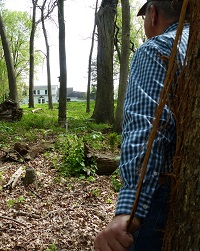
The distance from the lightning strike to the house is about a football field.
Lighting can be both lethal and sneaky. Every year it strikes about 25 million times in the United States and kills an average of 49 people. Many more humans are hit but survive, often with lingering physical problems. Ligntning is nothing to fool around with. As we learned on April 27th sometimes lightning strikes well before the main storm arrives and after it leaves. The safest place to be is inside a building away from windows, pipes, water, wires and landline telephones.
To stay safe, follow the 30-30 rule of thumb. When you first see lightning, begin to count “One Mississippi, two Mississippi….” until you hear thunder. If you hear thunder before you reach the number 30, lightning from the storm is in striking distance. Go inside! And, after the last rumble of thunder wait 30 minutes before venturing outside again.
An outstanding source of information, including many safety tips, is on the US Government’s website.


































